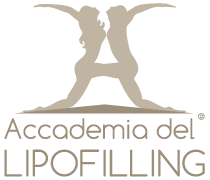This procedure is a means of breast augmentation, i.e., increasing the volume and improving the profile of the breast. It is performed without the use of breast implants, and in certain cases may be used to reconstruct the breast after tumour removal.
The operation
Lipofilling is performed in an operating theatre that conforms to the highest sterility and patient safety standards. If a large amount of fat is required for the procedure, the patient is given a general anaesthetic; otherwise the operation can be performed under local/regional anaesthesia and sedation.
The fatty tissue is harvested by inserting a small cannula, connected to an aspirating syringe (liposuction) into a donor region of compact adipose tissue rich in stromal vascular fraction, an excellent source of adult stem cells (ADSCs). Donor sites are usually the abdomen, flanks (the so-called “love handles”) or thighs. Once harvested, the fat is treated to remove excess fluid, and loaded into small 3cc syringes.
Using micro-cannulas, it is then injected into the breast at various depths along micro-channels under the mammary gland, between the breast and the underlying pectoral muscle, and between the mammary gland and the skin. This procedure can be repeated several times until the desired effect is achieved, and up to a maximum of 250–300 cc can be injected into each breast at each lipofilling operation.
When a large increase in breast volume is required, the fat is generally harvested in association with a technique called liposculpture, which not only enables the breast to be augmented considerably, but also improves the profile of the flanks and thighs by removing a large amount of adipose tissue.
During the operation, the harvested fat must be centrifuged, and half of the material collected is lost during this process, meaning that candidates for this type of surgery must be suitable for liposuction, so that the required amount of tissue can be taken. For these patients the operation will have a dual benefit, removing excess adipose tissue from fatty areas, and, at the same time, increasing the size of the breasts.
Following the operation there will be a small scar at the donor site of roughly 3 mm (from the incision needed to insert the suction needle) but the recipient breast will remain unscarred, as the needles used for the graft are too fine to leave a mark. Thanks to its low invasiveness, this operation is considered very safe.
FAQs:
What kind of anaesthesia is used?
Local anaesthesia + sedation, or general anaesthetic
How long does the operation take?
2 – 4 hours
How long will I have to stay in hospital?
1 day or day surgery
When can I resume my normal social activities?
After 1 week
